You spent all day at the beach. Or maybe you were outside working in the garden through the afternoon. Perhaps you just sat in a chair reading, losing track of time. The result is the same: you’re sunburned. (Ouch!) Forgetting to apply sunscreen when you go outside results in painful burns and increases your risk for dangerous dermatological problems. You know that. But what about your dog? It turns out the same rules apply. Good thing we have a list of the best dog sunscreens!
Sunburn Dangers
If your dog spends too much time in the sun, they can develop sunburns. The process works the same as it does with us. According to Dr. Richard Goldstein, the Executive Director and Chief Medical Officer of U.S. Diagnostics for Zoetis, dogs suffer the same skin damage we do when they spend excess time in the sun.
“A dog’s skin can be damaged by the sun just like our own, so they require the same protection against the development of sunburn and skin cancer.”
~Richard Goldstein, DVM, DACVIM, DECVIM-CA
Dog Sunburn?
If you don’t use dog sunscreens regularly, you may not know what a dog sunburn looks like. It’s not that different from ours. Focus on the areas of your dog NOT covered by hair. This means the ears, nose, around the eyes, and the belly.
- Pink or red skin
- Dry, flaking skin
- Hair falling out
Is your dog uncomfortable in those areas? Yeah, they’re sunburned. (You know how you feel. They’re no different)
Skin Cancer
We know frequent sunburns increase our risk for skin cancer. That’s why every trip outside requires a thorough application of sunscreen. Dogs aren’t any different. If your dog experiences frequent sun exposure without dog sunscreen, their risk for the following skin cancers increases:
Does Your Breed Need Dog Sunscreens?
Before you panic and buy out the store’s stock of dog sunscreen, let’s take an in-depth look at things. Some dogs ARE more susceptible to sunburn than others. For instance, hairless dog breeds top the list. There’s no fur to protect their naked bodies. (This shouldn’t surprise their owners)
Dogs with white or light-colored fur also have a higher risk. Does your dog have a thin coat? Pink or white skin? Time to look into dog sunscreen. The common breeds that run the risk for sunburn include:
- Australian Sheepdogs
- Boxers
- Bulldogs
- Collies
- Dalmatians
- Golden Retrievers
- Greyhounds
- Pit Bulls
- Whippets
- Weimaraners
- Yellow Labrador Retrievers
However, ANY dog has the potential to get sunburned. Those sensitive areas are sensitive for everyone. If your dog goes out hiking, spends time in the swimming pool, or likes to spend time outdoors for long periods, they need dog sunscreen.
Dog Sunscreen Notes
You have sunscreen in your cabinet (of course you do). You can use that, right? Afraid not. Human sunscreen is NOT safe for use on dogs. You need to purchase a dog sunscreen to protect your dog.
Why? Human sunscreens are TOXIC to dogs.
NO Human Sunscreens
The majority of human sunscreens contain two key ingredients: zinc oxide and salicylates. We handle those ingredients fine, but dogs do NOT.
What’s the biggest problem with applying ANYTHING to your dog? They lick it off. This is where we get into issues with human sunscreen.
Zinc oxide, when ingested, causes GI upset. Okay, sounds worth the risk, right? (If you said yes, shame on you!) The problem is zinc also causes spontaneous destruction of red blood cells in dogs. This results in anemia. Now your dog needs a blood transfusion. Zinc poisoning is dangerous (it also occurs when dogs ingest pennies dated after 1982).
Salicylates are used in the production of aspirin. Dogs cannot ingest aspirin. When consumed, it can result in a gastric ulcer (a hole in the stomach). It also damages the kidneys and the liver.
Your dog needs sunscreen explicitly manufactured for them.
Applying Dog Sunscreens
Hopefully, everyone knows how to apply sunscreen on themselves. Putting dog sunscreen on your beloved canine is a little different. You only need a thin layer to the most sensitive parts of your dog: the nose, ears, and belly.
“You don’t have to apply to areas with hair because they’re usually well protected,” per Dr. Christine Cain, the Associate Professor of Dermatology at the University of Pennsylvania School of Veterinary Medicine.
You can usually skip paws since they face down. However, if your dog likes to sunbathe on their back, consider a quick coat on those precious paws.
If you want your dog to stay safe and protected during outdoor fun, make sure you follow these tips:
- Apply the dog sunscreen 20 minutes before going outside.
- Reapply every 4-6 hours (more frequently if your dog’s in the water).
- Keep your dog well-hydrated. (No heatstroke, please)
- Try to keep your dog out of direct sunlight.
- Provide shade so your dog has a place to cool off.
Choosing a Dog Sunscreen
You have a few options when it comes to selecting dog sunscreens. Consider your dog and their sun habits carefully. When it’s your dog’s health, you want to make the best decision possible.
- Fragrance-Free: We don’t mind smelling like a tropical paradise, but your dog DOES. Considering you’ll apply the dog sunscreen around their nose, skip any fragrance. You don’t want to irritate sensitive noses.
- Waterproof: Whether you have a dog swimming pool, a sprinkler, or a natural body of water, you want that sunscreen to stay in place. After all, you’re going to make sure your dog has a chance to cool off, right? (Of course, you are)
- UVA and UVB Protection: You want full-spectrum protection for your dog. UV rays are dangerous. Aim for the highest levels.
- Category: Dog sunscreens come in three different types. You need to decide which works best for you and your dog:
- Balm: Balms have a slightly firm texture. They come in tins or tubes. Often, they have a somewhat oily feel, which may leave a residue on longer coats.
- Lotion: You know what cream feels like; it’s similar to our sunscreens. The thicker consistency works into your dog’s skin nicely.
- Spray: Sprays are the lightest of the three categories. They sink into your dog’s skin to protect against the sun.
Best Dog Sunscreens
However your dog chooses to spend time outside, you want a dog sunscreen to keep them safe. Are you going for a hike up a desert trail? Pack the sunscreen along with the hiking boots. Are they taking a swim in the pool with the kids? Make sure the entire family has their sunscreen first. Preventing painful sunburns keeps everyone happy.
Best Balm Dog Sunscreens
Balms provide thick coverage for your dog’s sensitive nose and belly. Often, you get a handy applicator, making it easy to protect your dog during outdoor activities. Unhappily, none of these dog sunscreens have FDA approval, so it isn’t easy to gauge how much SPF protection you’re providing. So long as you keep that note in the back of your mind and make sure you reapply frequently, you’re probably good.
Are you going to an area frequented by mosquitos and other pests? Handy Hound makes the perfect dog sunscreen choice. Raspberry seed and carrot seed essential oils protect your dog from the sun, while cedarwood and lavender extracts repel pesky insects! There’s no official rating, but Handy Hound estimates an SPF of around 30. In addition, Cupuacu butter and coconut oil provide plenty of moisturizing to your dog’s sensitive skin, while rose geranium extract soothes any potential burns. That’s a lot for one sunscreen!
Downsides? All of those essential oils are potential allergy triggers – proceed carefully. The combination of scents may also be too much for some dogs.
The Good
- Estimated SPF of 30
- Cedarwood and lavender extracts repel insects
- Rose geranium extract soothes potential burns
The Bad
- Essential oils may cause allergic reactions
- Scents may be too much for some dogs
What about the rest of your dog? My Dog Nose It has you covered. This balm works on noses, ears, bellies, and any other part of your dog’s body despite the name. You can even use it to comfort dry, cracked paws. Your dog gets UVB protection from the sun. The balm is water-resistant, letting your dog play in the pool. Even with daily use, the 0.5-ounce jar lasts up to FOUR MONTHS!
The downsides? No UVA protection. You DO need to reapply this dog sunscreen every TWO hours. Also, the balm has a sticky feel to it, so avoid fur.
The Good
- UVB protection
- Water-resistant formula
- Works on noses, ears, bellies, and paws
The Bad
- No UVA protection
- Must reapply every 2 hours
- Sticky feel, so need to avoid fur
Natural Dog utilizes vegan ingredients in their dog sunscreen. Dozens of plant-based oils, including kukui nut oil and shea butter oil, protect your dog’s sensitive nose from the dangerous sun. Meanwhile, vitamin E and chamomile extract soften and heal dry skin. The easy push-up container makes it easy to apply the sunscreen. Best of all, there’s no scent to bother your dog.
So what are the downsides? You can only use this product around your dog’s nose. So you’ll have to use another sunscreen on the rest of their body. Also, there’s a slightly greasy feel to the sunscreen.
The Good
- Plant-based ingredients
- Push-up container makes application easy
- Vitamin E and chamomile extract soften and heal dry skin
The Bad
- Only safe for use around the nose
- Slightly greasy feel
Best Spray Dog Sunscreens
Spray dog sunscreens are easy to use. You can either spray the mist directly onto your dog (careful around the eyes!), or you can spray your hands and massage the sunscreen into your dog’s skin. The bottles tend to last as they cover more territory. However, they don’t lay down as thick a coat of protection.
Chris Christensen is another skin conditioner that doubles as a dog sunscreen. Their formula combines raspberry seed and carrot seed essential oils to condition your dog’s skin and protects it from the sun. In addition, coconut oil and shea butter condition your dog’s fur after the bath, giving them a healthy sheen. The spray is easy to apply, and the formula’s non-greasy.
Downsides? This spray is watery and thin, making it a little harder to manage. Also, there’s no FDA approval, so gauging actual sun protection is tricky.
The Good
- All-natural ingredients
- Works as an after-bath conditioner and dog sunscreen
- Non-greasy
The Bad
- Watery formula
If you’d rather not use an aerosol spray, Emmy’s provides a great solution. While Emmy’s doesn’t have FDA approval, they feel their SPF rating is around 30. The non-toxic ingredients include shea butter and coconut oil to condition your dog’s coat. In addition, the formula isn’t greasy, preventing your dog from collecting dirt while they play outside.
The downsides? There is a strong scent to this sunscreen. You also need to reapply every couple of hours (more frequently than recommended).
The Good
- Estimated SPF of 30
- Non-toxic formula
- Non-greasy
The Bad
- Scent may be too much for some dogs
- Need to reapply more frequently than recommended
Epi-Pet ranks at the top as the ONLY dog sunscreen with FDA approval. (You gotta love that!) The UVA and UVB protection provides full-spectrum coverage with sweat and water resistance. In addition, the spray isn’t greasy or oily, leaving your hands feeling clean and your dog’s skin and fur comfortable. The formula even contains conditioners to help your dog’s coat stay soft and moisturized.
So what’s the downside? People don’t have much to say against this sunscreen. However, it can’t be used on or around cats, so watch where you’re spraying.
The Good
- Only dog sunscreen approved by the FDA
- UVA and UVB protection
- Sweat- and water-resistant
- Non-greasy
The Bad
- Not safe for use on or around cats
Gerrard Larriett focuses on natural ingredients: lavender, neem, lanolin, coconut, jojoba, and olive oil. The primary focus of the product is an after-bath conditioner, but you can also use it as a dog sunscreen. They also feel it works nicely to heal sunburned skin. (So, kind of a three-in-one product) You won’t feel any grease on your hands after applying this spray.
Downsides? Those essential oils present an allergic reaction hazard for many dogs. Proceed with caution. Also, the scents are overpowering for a lot of dogs. And, once again, there’s no FDA approval, so you don’t know what level of SPF protection you’re providing.
The Good
- All-natural ingredients
- Works as an after-bath conditioner, dog sunscreen, or to heal sunburned skin
- Non-greasy
The Bad
- Essential oils may cause allergic reactions
- Scent may be too much for some dogs
Sun Safety
There’s no reason not to enjoy time out in the sun. When the weather’s nice, there’s plenty of adventure to be had. Just make sure you and your dog are protected from the harmful rays. There are so many dangers from frequent sunburns. Dog sunscreens go a long way to preventing skin cancer.
So grab the spray or balm, and then hit the beach or trail!

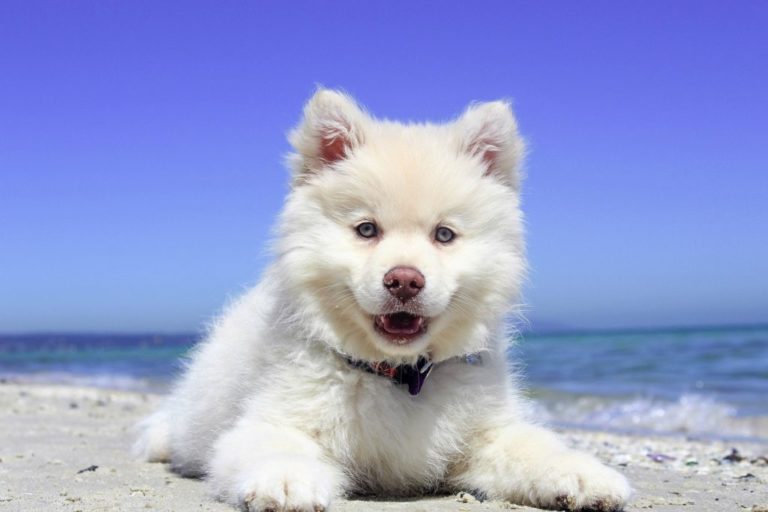
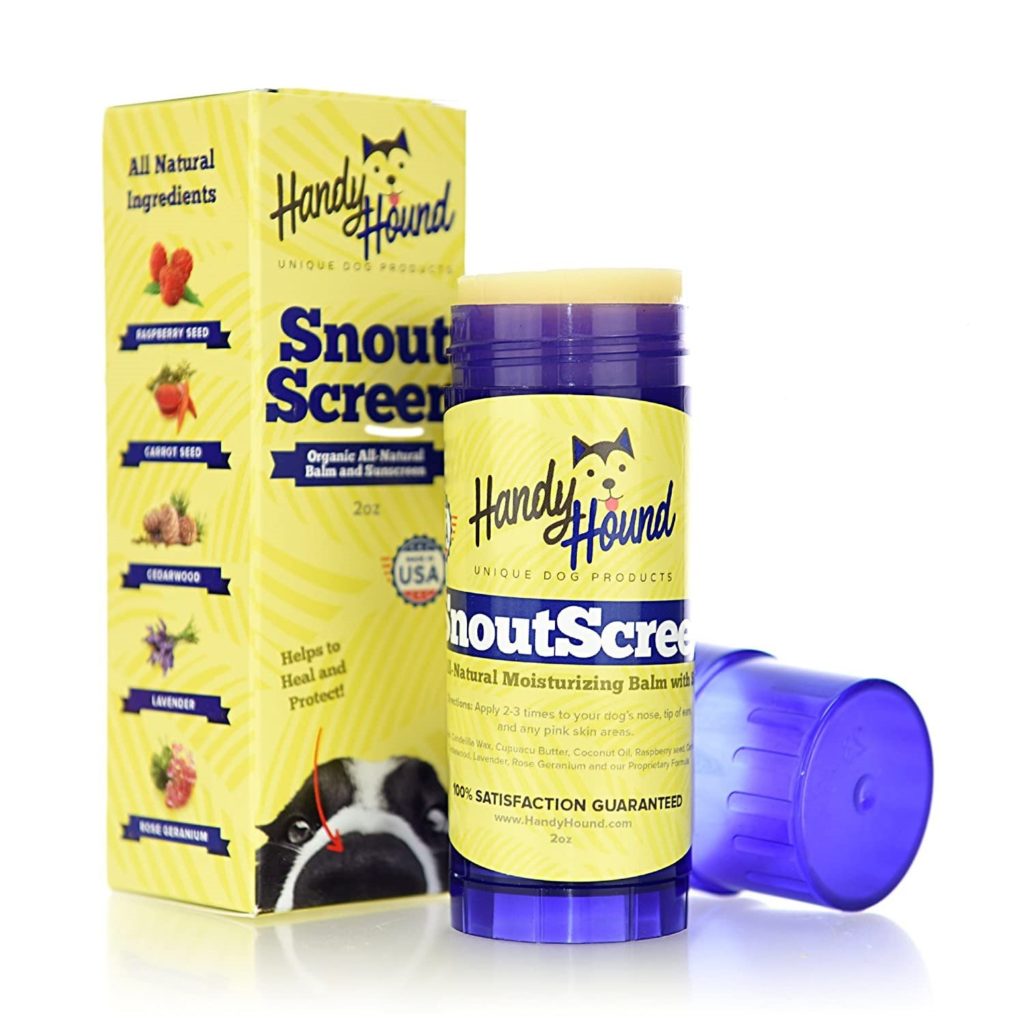
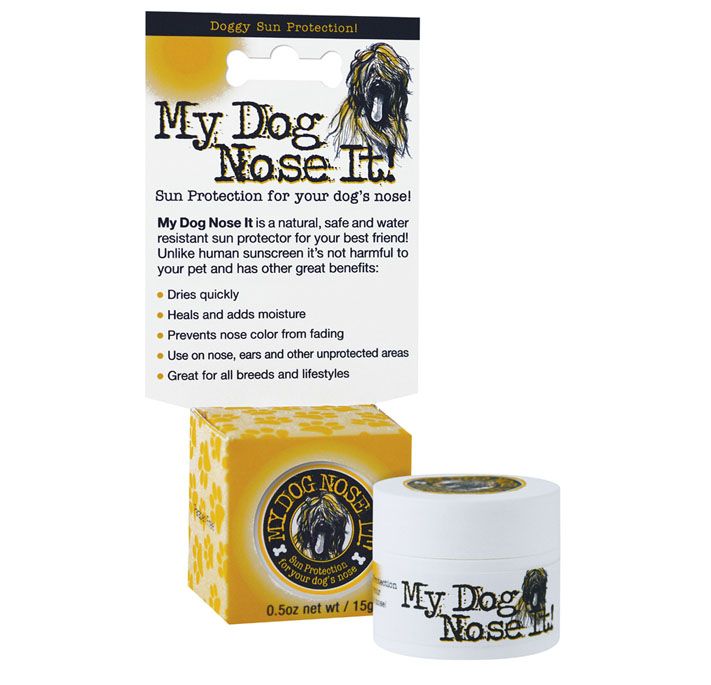
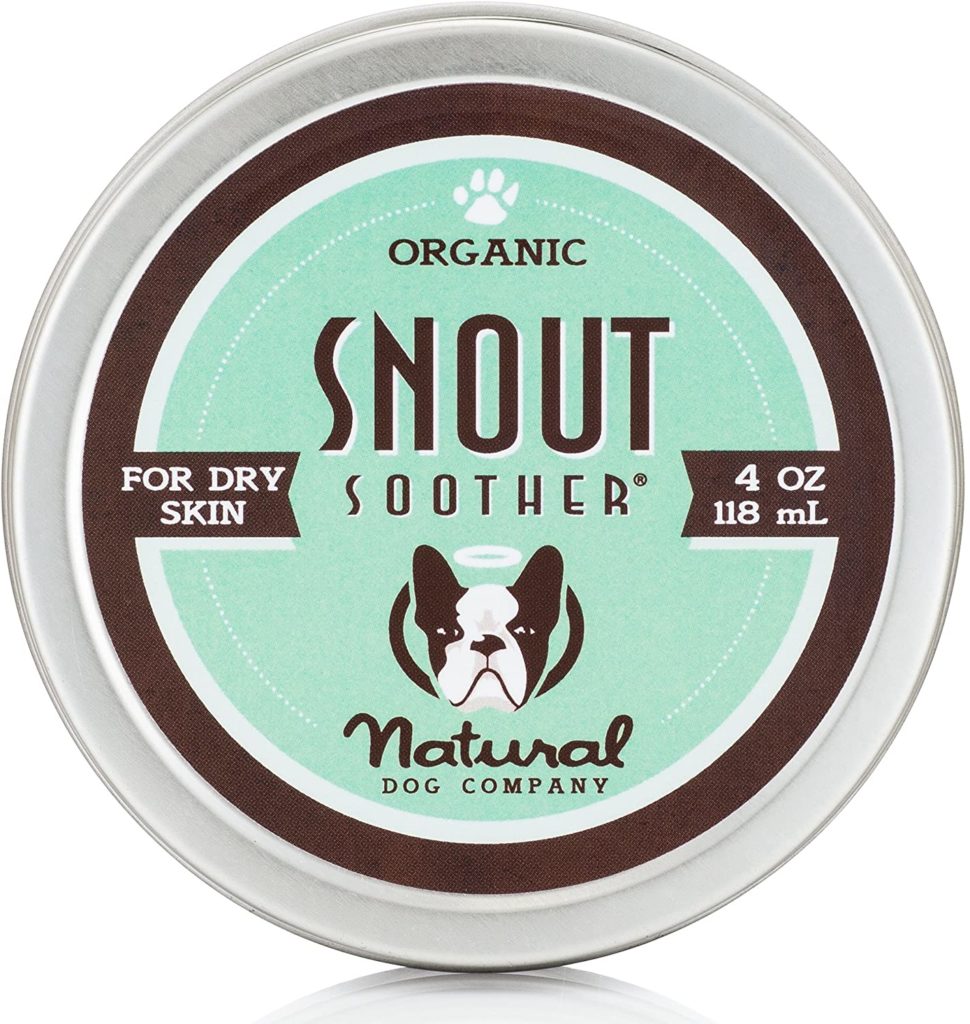

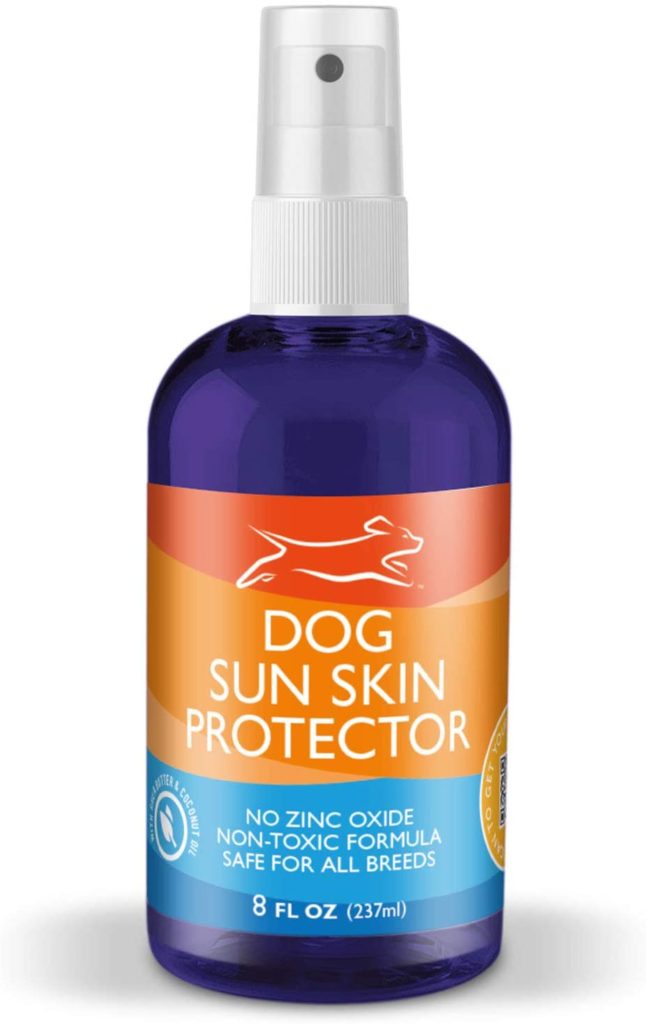

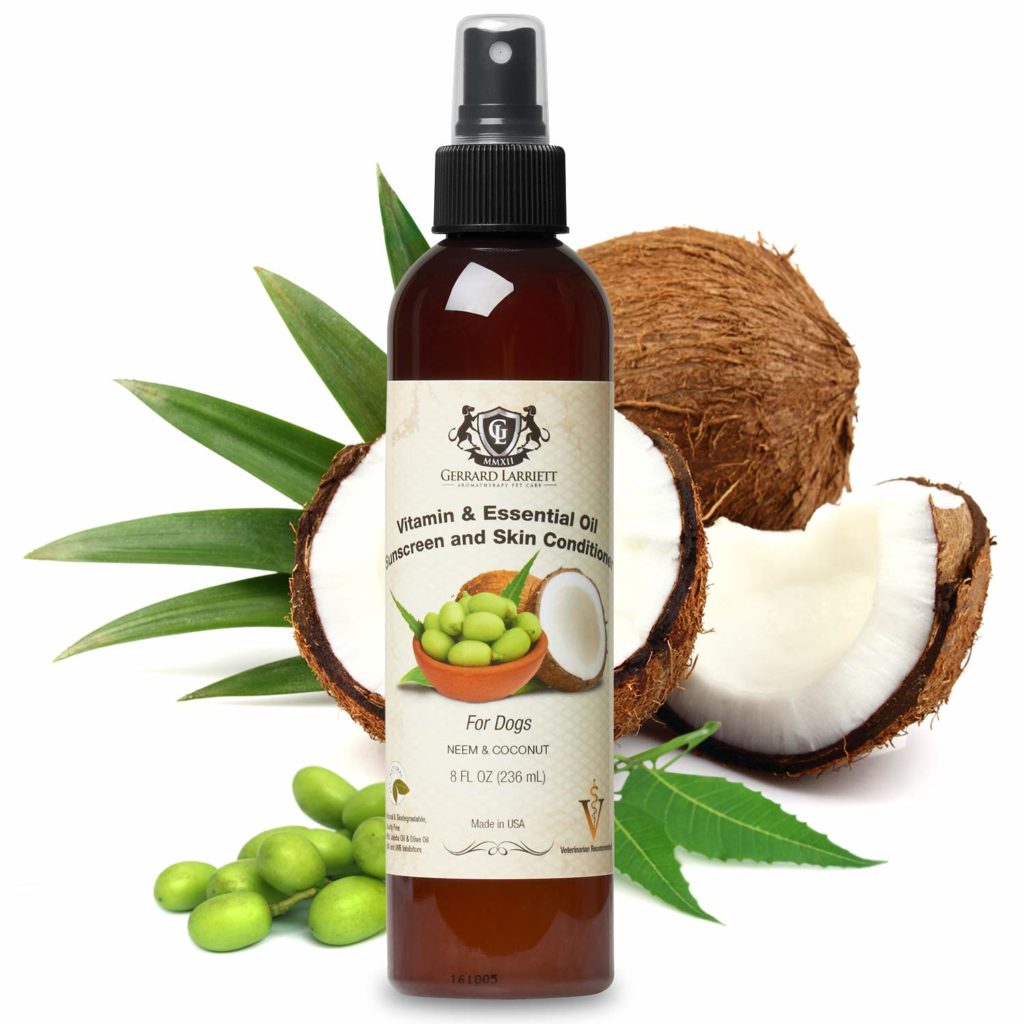




No comment yet, add your voice below!